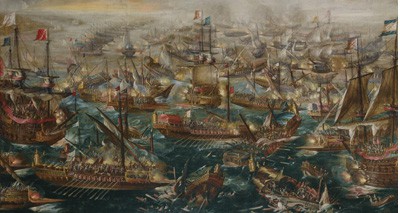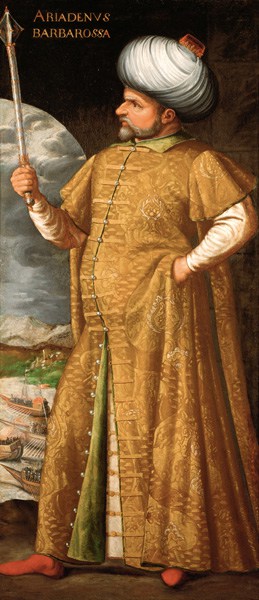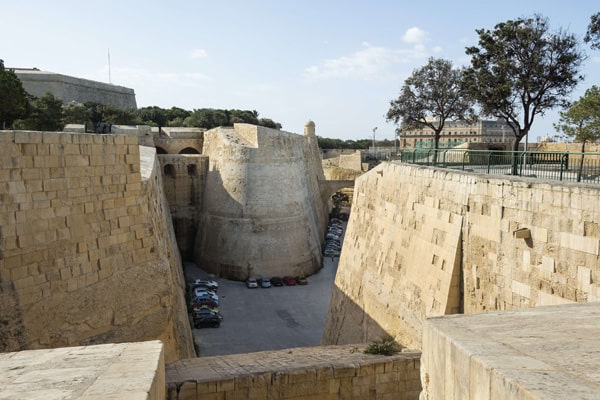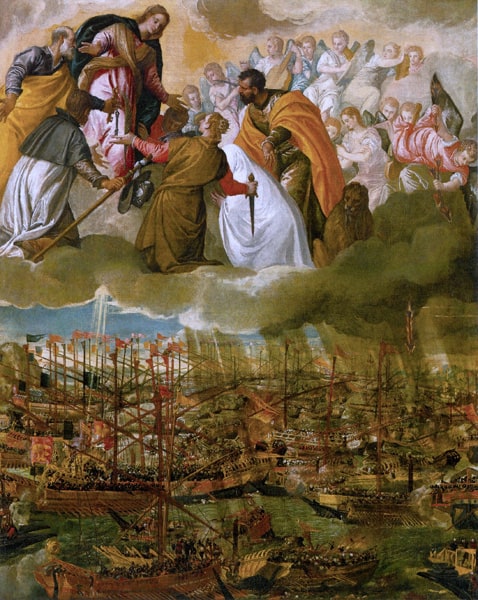The Battle That Saved Christendom
Sinclair Jenkins, American Renaissance, February 21, 2020

The media often depict the never-ending conflicts in the Middle East and North Africa as a war between Sunni and Shi’ite Muslims. That’s not the full picture. There is also a national and racial element to the conflict. Arabs, Persians, and Turks all claim to be “defenders” of the faith. The Arab claim is the strongest: Muhammad spoke Arabic, the Koran is written in Arabic, and by 750 AD, Arab-led armies ruled Syria, Palestine, Egypt, North Africa, and Spain, all of which were former Roman provinces and had been majority Christian.
Persian claims go back to the Abbasid Caliphate, which is commonly known as the Islamic “Golden Age.” Under the caliphs, Baghdad became a major city, with scholars and poets enjoying unprecedented prestige. However, Abbasid rule fractured the Muslim world as Baghdad tried to “Persianize” the empire. The caliphs adopted the rituals of the pre-Islamic Persian shahs, Persian became the language of the court, and Persians were never forced to learn Arabic. The government sponsored Persian math and poetry. The accomplishments of the Islamic “Golden Age” are overblown and relied on Greek and Assyrian Christian scribes, translators, and builders [1], but it is undeniable that the Abbasids helped spread both Islam and Persian culture [2].
It was the Abbasids who converted the nomadic Turks of Central Asia to Islam. Baghdad wanted to use Turks as soldiers against the breakaway Islamic states of North Africa and Spain, but the Turks became the strongest Islamic power in the world and the one group that managed to bring Islam to Southern and Eastern Europe. Turkic power relied on expert mobile warfare and a devotion to spreading the faith by the sword. One of the world’s most bloodthirsty conquerors was the Turco-Mongol Timur (Tamerlane), who killed countless people across Europe and Asia and established the Mughal Empire of India, which lasted until the British conquest.
Although Arabs first brought jihad to Europe, it was the Turks who did the most damage to Christendom. The struggle began after decades of Turkish settlement in Persia, the Middle East, and the Caucasus. Under the Seljuk beys [Turkish rulers], Turks established powerful states in eastern Asia Minor (today’s Turkey). This was a threat to the West, for Asia Minor was the ancient homeland of Greeks, Armenians, and Kurds, all of whom are Indo-Europeans. Western Asia Minor was ruled by the Eastern Roman (Byzantine) Empire, which was the direct descendant of the Roman Empire that spread Christianity throughout Europe, North Africa, and the eastern Mediterranean.
The first blows were struck in 1071 at Manzikert in what is now far Eastern Turkey. The Roman army that fought was led by Emperor Romanus IV Diogenes, with a force of approximately 40,000 men. It was a motley army of Anatolian peasants (the traditional backbone of the Eastern Roman military) and German and Frankish mercenaries. The elite troops were the Varangian Guard, a corps of Norse and Anglo-Saxon mercenaries. Varangian soldiers fought well at Manzikert, but Christendom lost the day because of poor strategy and intrigue.
Before the battle, Romanus made the bad decision to split his army by sending 12,000 Frankish mercenaries under the command of the warlord Roussel de Bailleul to Georgia. The emperor’s wife, Eudocia, was in league with Bailleul and other officers who wanted to replace Romanus with the empress’s son, Prince Michael VII [3]. A Turkish army encircled Romanus’s remaining men and slaughtered them. The emperor survived the battle, but the loss at Manzikert was the first step towards the Turkish conquest of Asia Minor. In 1453, a new Turkish dynasty, the Ottomans, conquered Constantinople, ending Christian power in the eastern Mediterranean.
Less than a hundred years after the fall of Constantinople, Ottoman armies threatened Central Europe. They controlled the old Eastern Roman lands of Greece, Albania, Macedonia, Bulgaria, Serbia, Croatia, and Bosnia and Herzegovina, while parts of Romania, Moldova, and Hungary were vassals of the sultan. British historian Roger Crowley notes that by the 16th century, for Christian Europe, the Ottoman Empire was the “cruelest enemy of Christ’s name” [4]. For the Catholic Church and all Catholic monarchs, the fight against the Ottomans was a fight for survival [5]. Islam demanded that the Ottomans fight against Christendom, and sultans legitimized their power through conquest.
As Crowley explains, the Ottoman decision to build a navy to control the Mediterranean led to much horror for Europeans. Ottoman pirates from North Africa began raiding Southern Europe by the early 16th century. The most famous of these pirates was Hayreddin Barbarossa, a corsair of mixed Albanian Muslim and Greek Orthodox background. (A tragedy of the Ottoman war on Europe was that many Ottoman soldiers, sailors, generals, and admirals were Europeans by blood or birth, and the majority of the sultans had European or Christian slaves for mothers.) Barbarossa turned Algiers into an open-air slave market for whites. During one raid in southern France, Barbarossa’s pirates captured 632 Christians and beheaded all priests and civic leaders [6].

Hayreddin Barbarossa. (Credit: Album / Fine Art Images)
In 1571, the Ottomans invaded Cyprus, which was then controlled by the Republic of Venice. After a prolonged siege, on August 17, 1571, the captured Venetian general Marc’Antonio Bragadin was asked if he would like to convert to Islam and thus be spared death. He refused. He was tied to an ancient column and skinned alive [7]. There were similar raids and massacres until the early 19th century. Over one million European men and women were taken as slaves by the Ottoman Turks and their Muslim allies in North Africa and Crimea. Slavery badly depopulated parts of Southern Europe for centuries.
The one group that consistently took the fight to the Ottomans was the Knights of Saint John (also known as the Knights Hospitaller). The Catholic military order fought heroically during the Siege of Rhodes in 1522. Although out-manned, they held the island from June until December. As part of a negotiated peace, the Ottoman victors let the knights leave Rhodes with their arms and armor. Rather than return to Europe, the Knights of Saint John made their new home on the island of Malta.
Malta sits in the middle of the Mediterranean, and its culture is a mixture of Greek, Sicilian, Arab, and Levantine. Maltese is a Semitic language, but because of the island’s closeness to Southern Europe and its steadfast Catholic faith, Malta was an integral part of Christendom. This made it a prize for the Ottomans, who besieged the island on May 18, 1565. It is estimated that between 35 and 40 thousand Ottoman soldiers attacked a series of forts held by 6,100 knights, foreign volunteers, and Maltese militiamen. After several weeks, the Ottomans captured Fort Saint Elmo:
For four hours the men [in the fort] held the line. Two hours before midday, there was a visible pause in the assault. When the janissaries and siphais lined up to attack again, there was no answering fire. The gunpowder was all gone. Six hundred men lay dead in the square and at the walls. The surviving defenders grasped swords and pikes and stood their ground, but the arquebusiers [people who used primitive firearms] no longer hid…hundreds of [Ottoman] men poured over the bridge and climbed the parapets unopposed, slaughtering all they met [8].

Valetta, Malta. Saint James bastion, part of the city walls of Valetta, built by the hospitaller knights of Saint John to protect the city against the Turks. (Credit Image: © Reporters/ZUMAPRESS.com)
Despite this victory, the Ottomans failed to take the remaining forts. The Christians used innovative tactics like the fire hoop (a wheel coated in tar and pitch and set alight), and primitive hand grenades and flamethrowers. The Christians also used their few cannons to great effect, while the Italian knight Vincenzo Anastagi used a small cavalry force to attack the Ottoman rear. On September 11, the demoralized Ottomans boarded their ships and went home.
Europe erupted into wild celebrations. Even in Protestant London and Stockholm, crowds cheered the heroism of the Catholic Knights of Saint John and the people of Malta. The old Sultan Suleiman the Magnificent, whose armies had laid siege to Vienna in 1529, took the loss as a sign that future Ottoman conquest lay in Hungary, not the Mediterranean. However, he died a year later, and his son, Sultan Selim II, sent his men back out to sea. Selim’s forces captured Cyprus and threatened Venice and the rest of the Adriatic.
Pope Pius V called for the formation of a new Holy League to face the menace. Before becoming pope, he had been a peasant from the Piedmont who practiced an ascetic faith and believed in the Crusades. In 1571, Pius managed to create a new league, composed of the Papal States, Hapsburg Spain, the Republic of Venice, the Republic of Genoa, the Knights of Malta (Knights of Saint John), and the duchies of Tuscany, Savoy, Urbino, and Parma. One of the strongest naval forces in Europe, the English Navy, did not take part because the British were Protestants. The most significant Catholic state not in the Holy League was France, which had an alliance with the Turks. [9].
The Holy League assembled a fleet of 316 Spanish, Venetian, and Genoese ships, with 50,000 sailors and 30,000 soldiers. Miguel de Cervantes, the future author of Don Quixote, served on board. The league was united in a common cause and a common faith, but national factions almost came to blows even before the first engagement with the Turks. Fortunately, the overall commander, Don Juan of Austria, managed to rally all the Christians. The Holy League fleet found the Ottoman fleet of 245 galleys in the Gulf of Patras on October 7, 1571; historian Crowley calls the Battle of Lepanto “killing on an industrial scale.” After four hours of close combat, “40,000 men were dead, nearly 100 ships destroyed, 137 Muslim ships captured by the Holy League” [10]. Of the 40,000 dead, 25,000 were Ottoman, with a further 3,500 Muslims taken as slaves. 12,000 Christian galley slaves were freed from Ottoman ships [11].

The Battle of Lepanto, Paolo Veronese, c.1572
The Battle of Lepanto became known as the battle that saved Christendom. King Philip of Spain almost bankrupted his country sending silver and gold from Spanish colonies in South America and the Philippines to support the Holy League. The Venetians deployed their state-of-the-art vessels known as galleasses to great effect. Historian Paul Davis writes that “Lepanto was a victory that spelled the end of Moslem naval power and ambitions” [12].
Lepanto was also a moral victory for the Europeans. It ended the prolonged sense of fear and inferiority brought on by years of slave raids. In Venice, the citizens celebrated for days. All across Europe, paintings and plays were dedicated to the victory, and one play, Cinthio’s A Moorish Captain, inspired William Shakespeare to write Othello.
Lepanto and the long war against the Turks had repercussions in the New World. John Smith of Jamestown had been a soldier for the Hapsburgs and fought the Ottomans in Transylvania before becoming a slave of the Turks in Crimea. It was also the American Navy that ended the white slave trade in North Africa when, in 1815, Commodore Stephen Decatur defeated the Ottoman corsairs of North Africa.
Most Americans do not know this history. The historic American nation is tied to the history of Europe’s long war against the Ottoman Empire. Americans once saw themselves as transplanted Europeans, whose civilization was an extension of Christendom. Turks threaten Europe today. Turkish President Recep Erdogan claims that Europe’s future “belongs to them.” He believes in a kind of Neo-Ottomanism, and his troops in Syria and Libya are helping Arab jihadists. Pres. Erdogan acknowledges Muslim “refugees” as a Turkish foreign policy instrument in Europe.
The victories at Malta and Lepanto saved Europe. We now face a different kind of Islamic imperialism, and we must defeat it again.
* * *
[1]: Dario Fernandez-Morera, The Myth of the Andalusian Paradise: Muslims, Christians, and Jews under Islamic Rule in Medieval Spain (New York: Open Road Media, 2016): Kindle edition.
[2]: The Earth and Its Peoples: A Global History, Volume 1, Ed. Richard Bulliet, Pamela Crossley, Daniel Headrick, Steven Hirsch, and Lyman Johnson (Boston: Cengage Learning, 2010): 238.
[3]: Paul K. Davis, 100 Decisive Battles: From Ancient Times to the Present (New York and Oxford: Oxford University Press, 1999): 120.
[4]: Roger Crowley, Empires of the Sea: The Siege of Malta, The Battle of Lepanto, and the Contest For the Center of the World (New York: Random House, 2008): xvi.
[5]: Ibid.
[6]: Crowley, Empires of the Sea, 68.
[7]: Crowley, Empires of the Sea, 241.
[8]: Crowley, Empires of the Sea, 138-139.
[9]: Crowley, Empires of the Sea, 66.
[10]: Crowley, Empires of the Sea, 276.
[11]: Ibid.
[12]: Davis, 100 Decisive Battles, 198.















